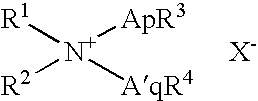Fabric treatment composition
a technology of fabric treatment and composition, applied in the direction of detergent dyes, detergent compounding agents, metabolic disorders, etc., can solve the problems of dyed fabrics to loose colour, loss of fabric colour with repeated laundering, dyed fabrics to lose colour,
- Summary
- Abstract
- Description
- Claims
- Application Information
AI Technical Summary
Benefits of technology
Problems solved by technology
Method used
Image
Examples
example 1
The following compositions A to I are fabric treatment compositions according to the present invention:
example 2
0.5 g drimarene navy K-BNN dye and 40 g sodium benzoate are dry mixed together to form a free flowing dye premix. The dye premix is then compressed using a Lloyd material tester LR50K under a pressure of 21834kNm-2 to form a dye tablet. The dye tablet is then crushed to form dye particles having a particle size of from 10 micrometers to 1000 micrometers, having a mean particle size of 300 micrometers. The dye particles are then added to base composition comprising 10 g surfactant, 30 g sodium carbonate, 2 g enzyme, 1 g perfume, 10 g acetate, 6 g zeolite A to form a composition in accord with the present invention.
example 3
0.5 g drimarene navy K-BNN dye and 40 g sodium benzoate are dispersed in 2 g bis((C.sub.2 H.sub.5 O)(C.sub.2 H.sub.4 O).sub.30)(CH.sub.3)--N.sup.+ --C.sub.6 H.sub.12 --N.sup.+ --(CH.sub.3) bis((C.sub.2 H.sub.5 O)-(C.sub.2 H.sub.4 O)).sub.30, at 50.degree. C. to form a dye dispersion. The dye dispersion is extruded using a twin screw extruder to form extruded material. The extruded material is cut to form dye particles having a particle size of form 10 micrometers to 1000 micrometers, having a mean particle size of 300 micrometers. The dye particles are added to a base composition comprising 10 g surfactant, 30 g sodium carbonate, 2 g enzyme, 1 g perfume, 10 g acetate, 6 g zeolite A to form a composition in accord with the present invention.
PUM
| Property | Measurement | Unit |
|---|---|---|
| molar ratio | aaaaa | aaaaa |
| molar ratio | aaaaa | aaaaa |
| molar ratio | aaaaa | aaaaa |
Abstract
Description
Claims
Application Information
 Login to View More
Login to View More - R&D
- Intellectual Property
- Life Sciences
- Materials
- Tech Scout
- Unparalleled Data Quality
- Higher Quality Content
- 60% Fewer Hallucinations
Browse by: Latest US Patents, China's latest patents, Technical Efficacy Thesaurus, Application Domain, Technology Topic, Popular Technical Reports.
© 2025 PatSnap. All rights reserved.Legal|Privacy policy|Modern Slavery Act Transparency Statement|Sitemap|About US| Contact US: help@patsnap.com



